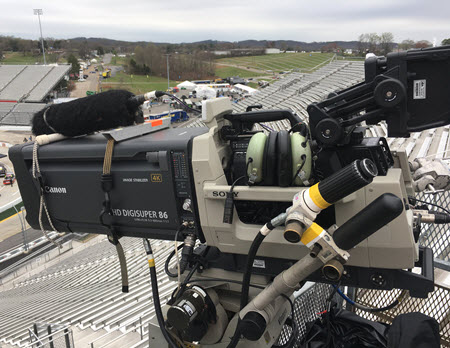Fox Sports Kicks Off 4K Gridiron Action

4K TV is not yet a mass-market phenomenon, but Fox Sports said it’s preparing for an inevitable “evolution” once the pixel-packed format is widely adopted by distribution partners and consumers.
Fox Sports, which has already produced some NASCAR races and college basketball games in 4K, is taking another step forward this fall as it moves ahead with a plan to produce one college football game per week in 4K — for a total of 13 games.
The first took place on Sept. 2, when the Maryland Terrapins visited the Texas Longhorns.
Fox Sports will distribute its full slate of college-football games in 4K with DirecTV, which has been using its satellite-TV platform to spearhead an ambitious strategy around the emerging video format.
“They’ve got the distribution, and they have the technology to move 4K from the remote [location] to the house,” Michael Davies, Fox Sports senior vice president of field and technical operations, said.
Fox is also discussing 4K distribution of those games with Layer3 TV, the Denver-based IPTV cable operator that supports 4K on all its boxes that has launched service in markets such as Washington, D.C., Los Angeles; Chicago; Washington, D.C.; Dallas/Fort Worth and Longmont, Colo., with New York on deck.
4K’s College Try
The college football slate represents Fox Sports’s most significant 4K project to date.
“This gives us a great opportunity to flex our muscles a bit with what 4K can be,” Davies said. “College football at this level is something that can be done in 4K and can be done successfully, so we’re excited about giving it a try.”
Davies said the 4K college football productions will offer some efficiencies because Fox Sports can produce the event in 4K and downconvert it for a wider audience watching the game in HD or standard definition.
“You don’t need to make too many sacrifices in terms of the production level [and] the end cost,” he said.
Additionally, these productions will take advantage of other features usually found in a standard football broadcast, such as on-screen graphics and yellow lines that mark first-down locations, but designed for 4K-level resolutions.
“The graphics look beautiful in 4K,” Davies said. “I think that puts the sheen on the whole production.”
Unlike its earlier NASCAR productions, Fox Sports won’t need to roll in a separate truck for the 4K college football productions, and it will need only one production crew to pull them off. (That wasn’t the case for 3DTV productions, which required separate crews and a different set of cameras.)
For this year’s games, Fox Sports has earmarked a 4K truck from Denver-based Mobile TV Group that also did some work with NBC to produce a handful of Notre Dame football games in the format.
“It’s got some reps under its belt,” Davies said, noting that the productions will use the guts of the 4K truck while preserving the overall workflow. “The goal is to put all of this in one truck.”
Though Fox Sports will learn some new 4K lessons this fall, it’s also drawing on some that it got from its earlier 4K productions.
“Organization is key,” Davies said. “You have to organize yourself very well to make sure you don’t run out of inputs.”
Plus, Fox Sports plans to be selective on what can be upconverted and inserted seamlessly into the 4K feed. Replays, for example, are still done in HD and upconverted for the 4K telecast.
Looking ahead, Davies said Fox Sports is “itching to get our hands on some HDR production,” referring to High Dynamic Range, an emerging technology that will make the pixels brighter and more colorful and complement the pixel density afforded by 4K.
“When we look at the evolution of the format … the Holy Grail is 4K HDR,” Davies said. “That’s what’s we’re working towards. We think there’s a lot of benefits that come from the combination of resolution and High Dynamic Range, but we’re not quite there yet.”
Also not there yet is widespread consumer adoption of 4K TVs. While the pace of 4K/UHD TV adoption is ahead of the transition from standard-definition to HD, according to the Consumer Technology Association, there’s still a lot of ground to capture.
Shipment of 4K TVs in North America are expected to more than double, from 11.7 million in 2016 to 25.9 million in 2020, according to IHS Markit.
Said Davies: “4K is an evolution. For us, this is an opportunity to work week over week in this space, and it also gives us a laboratory to experiment with different things in 4K.”
Multichannel Newsletter
The smarter way to stay on top of the multichannel video marketplace. Sign up below.
